Abstract
This paper explores contemporary approaches to preserving and promoting cultural heritage by integrating game elements and advanced technologies, such as Virtual Reality (VR) and Augmented Reality (AR). In an era increasingly shaped by digital innovation, preserving cultural heritage demands new strategies to sustain engagement with historical narratives and artifacts. Emerging technologies like VR and AR offer immersive, interactive experiences that appeal to modern audiences, especially younger generations accustomed to digital environments (Bekele and Champion). Gamification—the use of game design principles in non-game contexts—has gained significant traction in education and cultural heritage, providing new methods for increasing user engagement and retention (Werbach and Hunter). By incorporating gamified features, heritage can be made more accessible, fostering emotional connections and deeper understanding (Huotari and Hamari; Zichermann and Cunningham). This aligns with the shift toward interactive digital storytelling as a tool to transform static heritage presentations into dynamic, participatory experiences (Champion and Rahaman). Central to this research is the conceptualization and development of a mobile application leveraging VR and AR to enhance user engagement and education around cultural heritage. Drawing on the principles of self-determination theory (Deci and Ryan) and empirical findings on gamified learning (Landers and Landers), the application combines educational content with interactive elements, creating an immersive learning environment. By addressing both content accessibility and interactive immersion, this application bridges the gap between traditional heritage preservation and the expectations of a digitally native audience. The recent literature underscores the potential of VR and AR in cultural preservation, emphasizing their ability to transcend physical boundaries, simulate historical environments, and promote active participation (Milgram and Kishino, Addison; Azuma). As virtual environments evolve, platforms like the metaverse expand possibilities for experiencing cultural heritage in spaces free of geographical limitations (Cipresso et al.; Radianti et al.). Such advancements have already demonstrated significant educational and experiential benefits (Wu et al.; Akçayır and Akçayır). This study employs both quantitative and qualitative methods to examine the target group’s attitudes toward gamified technologies for cultural heritage preservation. The initial results indicate substantial interest and willingness among users to engage with applications employing VR and AR. This aligns with findings in the literature that suggest immersive experiences can enhance learning outcomes and foster long-term engagement (Merchant et al.; Speicher et al.). The project has garnered significant recognition, receiving the Rector’s Award for the best scientific paper in the technical field at the University of Zagreb and earning bronze medals at the ARCA Innovation Fair and the INOVA Fair. These accolades underscore the project’s innovative approach and its potential for real-world application. By presenting a robust framework for integrating gamification and immersive technologies into cultural heritage preservation, this paper contributes to the growing discourse on utilizing advanced digital tools to ensure the sustainability and relevance of cultural heritage for future generations.
1. Introduction
The preservation of cultural heritage is a critical issue in modern society, especially in the context of globalization and digitalization. The rapid development of technology opens new possibilities for preserving and popularizing cultural heritage, but at the same time, it presents challenges in integrating these technologies into educational and conservation practices. The use of immersive technologies, such as VR and AR, combined with gamification and the concept of the metaverse, offers innovative approaches that can enhance user interactivity and engagement in the learning processes related to cultural heritage.
The aim of this paper is to explore and analyze how gamification, immersive technologies, and the metaverse can be used to preserve and popularize cultural heritage and how the development of a mobile application can promote education and increase engagement among various age groups. Specifically, this paper will focus on the development of an app that combines 3D modeling of cultural artifacts with gamification elements within the metaverse to create an interactive and educational experience for users.
2. Hypotheses and Research Questions
Based on the definition of the problem, the following hypotheses will be explored in this paper:
H1.
The integration of immersive technologies (VR and AR) and gamification within the metaverse in educational programs significantly increases user engagement and motivation for learning about cultural heritage.
H2.
The target group shows a high interest in using mobile applications that employ modern technologies, including the metaverse, for cultural heritage education.
H3.
The development of a mobile application that combines 3D modeling of cultural artifacts with gamification elements within the metaverse can raise awareness and understanding of cultural heritage among young people.
To test these hypotheses, this paper will address the following research questions:
- -
- How does the target group perceive the use of VR and AR technologies, as well as the metaverse, in cultural heritage education?
- -
- To what extent can gamification within the metaverse enhance the learning experience and user engagement in the context of cultural heritage preservation?
- -
- What are the key characteristics of a mobile application that could attract and retain users interested in cultural heritage within the metaverse?
Research Methodology
This study uses a combination of quantitative and qualitative research methods applied in several phases to provide comprehensive insight into the target group’s attitudes and evaluate the effectiveness of immersive technologies and gamification in cultural heritage education.
The first phase consists of qualitative research, including focus groups and in-depth interviews with key stakeholders, such as educators, cultural heritage experts, and potential app users. This phase will provide a deeper understanding of the specific needs, challenges, and opportunities for integrating VR and AR technologies into educational programs. Focus groups will facilitate interactive discussions on user perceptions and expectations, while interviews will offer detailed insights into experiences and expert opinions on the application of technologies in cultural heritage preservation.
The second phase involves the experimental implementation of a developed prototype mobile application that combines gamification and immersive technologies. The prototype will be tested through a pilot program with the target user group. This phase will include an evaluation of user experience, engagement, and the educational effectiveness of the app. The evaluation will be based on a combination of quantitative methods (e.g., satisfaction surveys) and qualitative methods (e.g., feedback through interviews).
The final phase of this research will encompass the analysis of the collected data from all previous phases, aiming to assess the success of the applied methodologies and technologies in achieving this study’s objectives. The primary analysis will focus on identifying key factors that influence user engagement and their learning experience regarding cultural heritage through immersive technologies and gamification. Based on the research results, recommendations will be made for further development and improvement of the mobile application, as well as suggestions for applying the findings in the broader context of cultural heritage education and preservation.
3. Theoretical Part
The introduction of new technologies into the educational system brings many advantages but also challenges. Understanding the theoretical foundations behind the application of gamification, immersive technologies, and the metaverse in education is crucial for the development of effective educational tools and methods. This theoretical framework provides an overview of key concepts and theories that support the use of gamification, XR, AR, VR technologies, and the metaverse in education, with a particular focus on their role in the preservation and promotion of cultural heritage.
First, the history and development of gamification will be considered, starting from its early roots in education to its modern applications in digital environments. Gamification has become a significant tool for motivating and engaging students, and its use in educational contexts offers opportunities to enhance the learning experience through interactive and entertaining elements [1].
Next, the psychological and pedagogical aspects of gamification will be explored, explaining how and why games can be effective in education. Special attention will be given to self-determination theory and flow theory, which provide insights into the motivational mechanisms that gamification activates in students. These aspects are key to understanding how gamification can improve learning and why it is increasingly integrated into educational programs [2].
Furthermore, the chapter will address XR technologies and the metaverse, their foundations, and their potential applications in education. Technologies like VR, AR, and the metaverse enable the creation of immersive educational experiences that go beyond traditional teaching methods. These technologies are particularly useful in the context of cultural heritage preservation, allowing users to explore and learn about historical sites and artifacts interactively and participate in globally accessible virtual environments where they can collectively explore and share knowledge about cultural heritage [3].
Finally, the theoretical framework will cover the application of 3D modeling in education and the preservation of cultural heritage. The digitalization of artifacts and historical sites through 3D modeling, especially within the metaverse, offers new opportunities for documentation, research, and education, making cultural heritage accessible to a broader audience, including those unable to physically visit certain sites [4].
This theoretical framework provides a solid foundation for the further development of the work, enabling a deeper understanding of the key concepts and technologies applied in the project. Based on this overview, the following chapters will delve deeper into the specific aspects of gamification, XR technologies, and the metaverse, and their integration into educational programs aimed at preserving and promoting cultural heritage.
3.1. Gamification in Education
Gamification, as a concept and methodology, is gaining increasing importance in educational contexts, offering innovative ways to enhance student engagement and motivation. It is based on the use of game design elements in non-gaming contexts, which allows for the creation of a stimulating and motivating learning environment. By introducing elements such as points, badges, challenges, and competitions, gamification can significantly improve the learning experience, encouraging students to actively participate and achieve their goals [5].
3.1.1. History and Development of Gamification
Gamification as a concept is not new, although the term “gamification” was first used only at the beginning of the 21st century. The roots of gamification date back to the early 1980s when various forms of games and simulations began to be used in business environments and education. Pioneering examples of gamification included the use of simulations and training games within corporate settings to improve employee efficiency and motivation [6].
The first theoretical works formalizing the concept of gamification appeared in the late 2000s, aiming to apply gaming elements across various industries, including marketing, healthcare, and education. A key moment in the development of gamification occurred with the rise of digital platforms and mobile applications, which facilitated the easier integration of game mechanics into everyday activities [7]. In education, gamification was quickly recognized as a tool that could increase student engagement, especially in contexts where motivation is traditionally low, such as online learning or subjects perceived as boring [8].
3.1.2. Psychological and Pedagogical Aspects of Gamification
Gamification is based on several key psychological principles that foster motivation and engagement. One of the main principles is intrinsic motivation, which refers to an individual’s internal drive to engage in activities for personal satisfaction or interest rather than external rewards [9]. Gamification uses elements such as challenges, competitions, and reward systems to enhance students’ intrinsic motivation. Through goal achievement, feedback, and recognition of accomplishments, students develop a sense of competence and achievement, further boosting their motivation [10].
From a pedagogical perspective, gamification can be integrated into various learning methods, including problem-based learning (PBL) and project-based learning. These approaches allow students to explore complex problems and develop solutions through play, increasing their engagement and active learning. Furthermore, gamification can help develop social skills and collaboration among students, as many gamified activities involve teamwork and collective problem solving [11].
Self-determination theory (SDT), which relates to the three basic psychological needs—autonomy, competence, and relatedness—is also crucial in understanding the success of gamification in education. Gamified systems can meet these needs by providing a controlled environment where students can experiment and learn at their own pace (autonomy), feel capable and competent (competence), and connect and collaborate with others (relatedness) [12].
Gamification also allows for personalized learning, adapting content and task difficulty to the individual abilities and preferences of students. This approach not only increases learning effectiveness but also reduces stress and anxiety associated with learning, as students have control over their progress and pace [13].
Based on these psychological and pedagogical aspects, it is clear that gamification has the potential to significantly improve the quality of the educational experience, especially in contexts where traditional learning methods fall short of achieving high engagement and student motivation.
3.2. XR Technologies in Education
XR (Extended Reality) technologies, which encompass VR (Virtual Reality), AR (Augmented Reality), and MR (Mixed Reality), have emerged as transformative tools in the field of modern education. These technologies provide educators and students with the ability to create and experience immersive environments that significantly enhance learning outcomes. By offering highly interactive and visually stimulating experiences, XR technologies enable students to gain a deeper understanding of complex subjects and engage with educational content in a more hands-on and intuitive way. The integration of the real and digital worlds allows for innovative learning approaches, where virtual simulations, interactive models, and remote experiences can be explored in a manner that was previously impossible or cost prohibitive.
One of the key advantages of XR technologies is their ability to provide students with access to environments and scenarios that would be otherwise inaccessible, such as exploring historical landmarks, conducting virtual science experiments, or interacting with abstract concepts in a tangible way. These virtual expeditions and simulations are not only beneficial for students who may have limited access to physical resources, but they also foster greater engagement and retention of knowledge. For example, medical students can practice surgeries in a virtual environment, while history students can walk through ancient civilizations, all from the comfort of their classroom or home. Furthermore, XR technologies have been shown to support collaborative learning, where students can work together in shared virtual spaces, overcoming physical limitations and encouraging teamwork and problem solving.
As XR technologies continue to evolve, they promise even greater possibilities for education, allowing for more personalized learning experiences that cater to the diverse needs of students. The continued integration of VR, AR, and MR into educational contexts will likely lead to more dynamic, effective, and inclusive learning environments that can better equip students for the challenges of the future [14].
3.2.1. Virtual Reality (VR)
VR (Virtual Reality) technology allows users to immerse themselves in a fully synthetic, computer-generated environment using devices like VR glasses or headsets. In the field of education, VR is increasingly being leveraged to create experiences that provide students with access to environments and scenarios that would otherwise be inaccessible, such as historical landmarks, outer space, or microscopic worlds. One of VR’s most powerful features is its ability to generate a strong sense of presence—making users feel as though they are truly “inside” the virtual environment. This immersion significantly enhances the learning experience, enabling students to engage with content in a more meaningful and memorable way. Studies have shown that this heightened sense of presence leads to improved knowledge retention and a deeper understanding of complex topics, making VR an effective tool for education [15].
The application of VR in education spans a variety of disciplines, including history, geography, science, engineering, and more. For instance, history students can virtually “visit” ancient civilizations and examine artifacts within their original contexts, offering a richer and more interactive approach than traditional textbooks or static images. Similarly, science students can explore the inside of cells, observe molecular structures in three-dimensional space, and interact with dynamic models of complex systems, all of which help to make abstract concepts more tangible and understandable [16]. Research indicates that VR-based learning not only increases student engagement but also facilitates a deeper understanding of intricate concepts, especially when combined with other interactive learning tools such as simulations and real-time collaboration [17].
Despite the significant advantages of VR in education, there are still several challenges that need to be addressed to maximize its potential. These include the high cost of VR equipment, the technical requirements for running VR-based applications, and the need to adapt curricula to fully integrate VR’s interactive features. Additionally, there are concerns regarding accessibility and the need for educators to develop the skills required to effectively use VR in teaching. However, despite these hurdles, VR remains one of the most promising technologies for revolutionizing education in the 21st century. As the technology matures and becomes more affordable, its potential to transform how we teach and learn will only continue to grow, offering new opportunities for personalized and immersive educational experiences [18].
3.2.2. Augmented Reality (AR)
AR (Augmented Reality) enhances the real world by overlaying digital information, images, sounds, and other multimedia content onto physical environments. Unlike VR, which requires full immersion in a digital world, AR integrates these virtual elements with the real world, allowing for a more accessible and user-friendly experience. This characteristic makes AR a powerful tool in education, where it is used to bridge the gap between theoretical knowledge and practical experience, without requiring complete immersion into a virtual environment [19].
AR is especially effective in fields where hands-on learning is essential. In biology, for example, AR can project models of the human body into the classroom, allowing students to explore the internal organs interactively, without the need for costly equipment or a laboratory setup. Similarly, in architecture and design, AR can be used to visualize building structures or room layouts within real-world environments before the physical construction begins. This gives students a clearer understanding of scale and spatial relationships, enhancing their learning experience without the need for physical models or prototypes [20].
The benefits of AR in education are numerous. It has been shown to significantly increase student engagement by creating interactive and immersive learning experiences. Additionally, AR allows for personalized learning, where students can engage with the material at their own pace and according to their own learning style. Furthermore, AR encourages a more dynamic interaction between students and the content, fostering greater retention of information. Research supports these findings, showing that AR improves both motivation and knowledge retention, particularly when used in conjunction with traditional teaching methods [21].
However, similar to VR, the successful integration of AR into educational settings requires adequate technical infrastructure and teacher training. Teachers need to be equipped with the skills to use AR effectively in their lessons, and schools must provide the necessary technical support to ensure smooth implementation. With these factors in place, AR has the potential to revolutionize education, offering new ways for students to interact with and explore the curriculum [22].
3.2.3. Mixed Reality (MR)
MR (Mixed Reality) merges elements of both VR and AR to create immersive environments where the digital and physical worlds coexist and interact in real time. By allowing users to manipulate digital objects within the real world, MR opens new possibilities for education, especially in fields such as engineering, medicine, and design. This combination of real and virtual elements enables students to engage with concepts in a highly interactive manner, enriching their learning experience and making it more dynamic and practical [23].
In the field of education, MR allows students to explore and manipulate complex systems and conceptual models in ways that traditional methods simply cannot. For instance, in medicine, MR can be used to simulate surgical procedures, giving students the opportunity to practice and refine their skills in a safe and controlled environment before performing real surgeries on patients. This offers a highly effective way of training medical professionals without the risks associated with practicing on actual patients [24]. In engineering, MR enables students to design, construct, and test prototypes in real spaces, drastically reducing development time and production costs. By virtually interacting with their designs, students can gain a better understanding of how their models work in the real world, providing valuable hands-on experience without the need for physical materials [25].
Despite the vast potential of MR in education, there are challenges to its widespread implementation. One of the primary obstacles is the complexity involved in integrating MR technology into the curriculum, which requires highly specialized equipment and expertise. Additionally, more research is needed to understand the full impact of MR on student learning and cognitive development. Although further studies are essential, MR holds immense promise in transforming education by enabling students to learn through direct experience and real-time interaction in ways that were previously unimaginable [26].
3.3. Digitalization and 3D Modeling of Cultural Heritage
The digitalization and 3D modeling of cultural heritage represent key tools in the modern preservation and popularization of cultural assets. Through the process of digitalization, cultural artifacts, monuments, and sites can be preserved in digital form, ensuring their long-term protection, easier accessibility, and interactive presentation to the public. Three-dimensional modeling, as part of this process, enables the creation of precise three-dimensional representations of cultural objects, offering new opportunities for their analysis, restoration, and educational use [27].
3.3.1. Digital Preservation of Cultural Heritage
Digital preservation of cultural heritage refers to the use of digital technologies to preserve, protect, and disseminate knowledge about cultural assets. This approach allows for the creation of permanent digital records of cultural objects that can be used for restoration, research, education, and presentation. Digital records also provide the possibility of virtual restoration, where damaged or lost parts of artifacts can be reconstructed using historical data and technologies such as 3D modeling and Virtual Reality [28].
One of the key aspects of digital preservation is its role in preventing the loss of cultural heritage due to natural disasters, wars, or deterioration from age. Digitization enables cultural artifacts to be preserved in their original condition and made available for future generations, even if the original items become inaccessible or destroyed [29]. Examples of successful initiatives in digital preservation include projects like CyArk, which uses 3D laser scanning to document world heritage, and Europeana, which digitizes cultural heritage across Europe [30].
Digitization also contributes to the democratization of culture, allowing broader access to cultural content through digital platforms. This means that people around the world can access information about cultural heritage regardless of geographic location, promoting global awareness and education about cultural values [31].
3.3.2. The Role of 3D Modeling in Documentation and Preservation
Three-dimensional modeling plays a crucial role in the process of documenting and preserving cultural heritage. This technology allows for the creation of accurate digital replicas of cultural artifacts and monuments, which can be used for various purposes, including restoration, education, and exhibition in museums or on virtual platforms [32].
The 3D modeling process typically involves technologies such as photogrammetry, laser scanning, and computed tomography, which allow for capturing detailed data about the physical characteristics of objects. These data are then processed to create a three-dimensional digital model that can be rotated, analyzed, and modified on a computer [33].
The role of 3D modeling in documenting cultural heritage is particularly important in the context of restoration and conservation. Digital models enable conservators to analyze the condition of artifacts accurately, plan restoration interventions, and simulate different restoration scenarios before physical work begins. This reduces the risk of damaging original items and allows conservators to make informed decisions about the best preservation methods [34].
Additionally, 3D models can be used to create replicas of cultural artifacts through 3D printing, allowing for museum work and education without the need to handle sensitive originals. Furthermore, 3D models enable the creation of interactive virtual tours and exhibitions, where visitors can explore cultural objects in a digital environment, further enriching their experience and understanding of cultural heritage [35].
3.3.3. The Role of the Metaverse Today
The metaverse, as a concept that combines AR, VR, and other immersive technologies into a unique digital environment, is becoming increasingly significant in contemporary society. Its role today extends far beyond the realms of entertainment and video games, crossing into the spheres of education, work, commerce, and even the preservation of cultural heritage.
One of the key roles of the metaverse is the transformation of how we communicate and collaborate. By creating immersive, three-dimensional worlds, the metaverse enables users to connect and collaborate in real time, regardless of their physical locations. This technology offers new opportunities for teamwork, particularly in the context of remote work, where users can share information and collaborate in a shared virtual space, creating a sense of presence and closeness that transcends traditional forms of online communication.
In education, the metaverse offers revolutionary opportunities for creating interactive and engaging experiences. Instead of passive learning, students can participate in simulations, virtual field trips, and other forms of interactive content that allow for deeper understanding and retention of information. For example, history students can “visit” ancient civilizations and explore historical events firsthand, while medical students can practice surgical procedures in a safe, virtual environment. The metaverse, therefore, is not just a tool for learning but also a means to foster critical thinking, creativity, and innovation.
In commerce, the metaverse enables the creation of entirely new shopping experiences. Users can “visit” virtual stores, try on products through AR and VR technologies, and make informed purchasing decisions. Brands use the metaverse to create personalized experiences for their customers, allowing them to connect with products and services in new and exciting ways.
In today’s world, the role of the metaverse is becoming increasingly important. As a comprehensive digital platform, the metaverse not only transforms the ways we work, learn, and communicate but also opens new horizons for preserving and promoting cultural heritage. Its further development promises to enrich human experiences, creating new opportunities for interaction, education, and the preservation of our shared values [35].
4. Analysis of Existing Solutions
The introduction of new technologies into the educational system brings numerous advantages as well as challenges. Understanding the theoretical foundations behind the application of gamification and immersive technologies in education is crucial for the development of effective educational tools and methods. This chapter analyzes existing solutions in the field of educational technologies, with a particular emphasis on gamification and XR, AR, and VR technologies. It provides an overview of the current state, examples of applications, and analyzes the effectiveness and challenges of implementing these technologies in an educational context, especially for the purpose of preserving and popularizing cultural heritage.
4.1. Overview of Existing Educational Applications in Education
The development of educational applications has seen significant growth in recent years, especially considering the accelerated technological advancement and increased availability of digital devices. Educational applications that utilize gamification and XR technologies enable students to engage in interactive learning and create a dynamic and engaging educational environment.
4.1.1. Examples of Gamified Educational Applications
Gamification, as the process of integrating game elements into a non-game environment, has been widely accepted in the education sector. Various applications employ reward mechanisms, scoring, competition, and levels to encourage students’ active participation and learning. Some of the most well-known examples of gamified educational applications include the following:
- Kahoot!—a popular quiz platform that allows teachers to create quizzes where students respond in real time. The competitive element and visually appealing interface foster student engagement [36].
- Duolingo—a language-learning app that uses gamification to motivate users to learn daily. The point and level reward system, along with daily challenges, allows users to compete against themselves or others [37].
- Classcraft—an educational platform that transforms the classroom into an interactive game where students take on character roles and collaborate to achieve learning goals. Gamification promotes teamwork and social–emotional development [38].
- Quizlet—an application that allows the creation of digital flashcards and quizzes. Gamified elements, such as playing against the clock and achieving high scores, make learning more interesting and stimulating [39].
These applications demonstrate that gamification can successfully motivate students, but they also highlight the need for careful design to avoid potential overwhelm or dissatisfaction among students.
4.1.2. Examples of XR Educational Applications
XR technologies, which encompass AR and VR, offer new opportunities in education by allowing students to interact with digital content in entirely new ways. The following examples illustrate how XR technologies are being utilized in education:
- Google Expeditions—an application that allows students and teachers to explore virtual tours together through various parts of the world, including historical sites and natural landmarks. The application uses VR to provide students with an immersive experience that cannot be achieved in the classroom [40].
- Merge Cube—AR allows students to hold digital objects in their hands using a physical cube and AR application. This technology is used in educational content to enable students to explore human anatomy, geological layers, and other scientific phenomena [41].
- Tilt Brush—a VR application used in the artistic education sector, allowing users to paint and create three-dimensional artworks within Virtual Reality. This application fosters creativity and enables learning through experimentation in a new medium [42].
- CoSpaces Edu—an application that enables students to create their own VR and AR worlds using a simple programming tool. This allows students to combine knowledge of programming, design, and storytelling to create educational projects [43].
- XR technologies expand the possibilities of traditional education, enabling students to immerse themselves in content in ways that would otherwise be impossible. However, their wide implementation comes with challenges related to costs, equipment availability, and the need for teacher training.
4.2. Analysis of Effectiveness and Challenges
Although gamification and XR technologies are increasingly present in education, their implementation carries a number of challenges. This analysis encompasses the advantages and disadvantages of gamification and examines the integration of XR technologies into the educational curriculum.
4.2.1. Advantages and Disadvantages of Gamification
Gamification in education offers numerous advantages, but it also comes with certain disadvantages. Key advantages include the following:
- Increased Engagement—Gamification encourages students to actively participate in the learning process through competition, rewards, and achievements. Research shows that students become more motivated when engaged in games [44].
- Improvement of Memory and Knowledge Retention—The use of gamified elements can enhance students’ ability to retain and apply learned material thanks to repetition and interactive learning methods [45].
- Development of Social Skills—Through team activities and competitive games, students develop social and collaborative skills [46].
However, gamification also has its drawbacks:
- Overemphasis on Rewards—Students may become too focused on winning rewards and less on actual learning, leading to a superficial understanding of the material [47].
- Adaptation Challenges—Gamification may not be suitable for all students or all subjects. Adapting games to be relevant and effective for different student groups can be complex [48].
- Increased Complexity for Teachers—Implementing gamification may require additional time and resources from teachers, including training and curriculum adjustments [49].
4.2.2. Integration of XR Technologies into the Curriculum
The introduction of XR technologies into educational curriculum represents a significant step forward but comes with a range of challenges and issues. Advantages include the following:
- Increased Motivation and Engagement—XR technologies provide students with the opportunity for immersive learning, where they can literally “dive” into the content. This can enhance their motivation and engagement [50].
- Improved Understanding of Complex Concepts—XR enables the visualization and manipulation of complex concepts that would otherwise be difficult to grasp, such as molecular structures or historical events [51].
- Personalized Learning—XR can provide a personalized educational experience tailored to individual student needs [52].
However, challenges remain:
- High Costs—Implementing XR technologies requires significant financial investment in equipment, software, and teacher training [53].
- Technical Issues—Technical problems, such as device compatibility, technical support, and equipment maintenance, can limit the widespread use of XR technologies in education [54].
- Potential for Information Overload—Too much information and sensory stimulation can lead to student overload, which can reduce learning effectiveness. In the context of XR technologies, there is a danger that excessive visual and auditory information at once may overwhelm students, making it difficult for them to focus on the key aspects of the lesson [55].
5. Qualitative Research—Focus Groups and Interviews
The qualitative research conducted in this study focuses on understanding the specific needs, challenges, and potential that key stakeholders identified in the integration of VR and AR technologies into educational programs. This research involved focus groups and in-depth interviews with professors, cultural heritage experts, and potential app users. The goal of this research was to identify and understand how these stakeholders perceive these technologies, what obstacles they recognize in their implementation, and what opportunities they see for enhancing educational experiences through their application.
The metaverse represents a new paradigm in the digital environment, offering unlimited opportunities for the preservation and promotion of cultural heritage. At its core, the metaverse is a virtual world where users can create, explore, and interact with digital replicas of real objects and artifacts. Given the rich history and cultural heritage many societies possess, the metaverse has proven to be an excellent tool for preserving cultural heritage, making it accessible and understandable on a global scale. Integrating the metaverse into this field is not only a technological innovation but also a cultural mission that offers new perspectives in the presentation and protection of cultural artifacts.
5.1. Methodology
This research was conducted in several stages, combining focus groups and in-depth interviews to cover a wide range of perspectives and experiences.
5.2. Participants
Participants were selected based on their experience and interest in cultural heritage and educational technologies. This research involved a total of 10 participants, divided into two focus groups and five individual in-depth interviews. The focus groups included the following:
- The first focus group consisted of five students from various faculties, some of whom had prior experience with VR and AR technologies.
- The second focus group included five students and professionals in cultural heritage, including museum curators, historians, and conservators.
In addition, five in-depth interviews were conducted with potential app users, including students, educators, and representatives of the general public.
5.3. Focus Groups
The focus groups facilitated detailed discussions among participants. The first focus group with students focused on the following:
- -
- Perception of VR and AR technologies in education.
- -
- Identified benefits and challenges in integrating these technologies.
- -
- Practical possibilities for applying VR and AR in existing curricula.
The second focus group on cultural heritage focused on the following:
- -
- Opportunities for using VR and AR technologies in the preservation and promotion of cultural artifacts.
- -
- Challenges related to the digitization and virtual presentation of cultural assets.
- -
- Expectations for collaboration between cultural institutions and technology companies.
5.4. In-Depth Interviews
In-depth interviews provided additional insights into participants’ personal attitudes and experiences. The questions included the following:
- How do you see the role of VR and AR technologies in education about cultural heritage?
- What challenges have you faced when using or considering the use of these technologies?
- What functionalities would you like to see in an app that uses VR and AR for education?
5.5. Data Collection Process
The focus groups were organized in a series of structured sessions held at various educational institutions and cultural heritage sites. Each session included 6 to 10 participants and was facilitated by a trained moderator who guided the discussions using a semi-structured interview format. This approach allowed participants to freely express their thoughts while ensuring that key topics were covered. Participants were encouraged to share their experiences and insights regarding the use of VR and AR in education, facilitating a dynamic exchange of ideas.
In addition to focus groups, in-depth interviews were conducted with selected stakeholders to gather more nuanced perspectives. These interviews, lasting approximately 30 to 60 min each, were conducted either face-to-face or via video conferencing platforms, depending on participant availability. Interview questions were designed to probe deeper into individual experiences, perceptions, and specific use cases for VR and AR technologies in educational contexts.
5.6. Ensuring Validity and Reliability
To ensure the validity and reliability of the research instruments used in this study, a series of steps were taken in the development and implementation of interview questions and focus group discussion prompts. Initially, the questions were constructed based on a comprehensive literature review, which provided a theoretical framework and highlighted key areas of inquiry relevant to the integration of VR and AR technologies in education.
Following the initial drafting, the interview questions and focus group prompts were subjected to a peer review process involving experts in the fields of education technology and cultural heritage. This step allowed for feedback on the clarity, relevance, and comprehensiveness of the questions, leading to necessary revisions that enhanced the quality of the instruments.
Additionally, a pilot study was conducted with a small group of participants similar to the target population. This pilot test aimed to assess the effectiveness of the questions in eliciting meaningful responses and to identify any ambiguities or biases in the wording. Based on the feedback from the pilot study, further adjustments were made to refine the instruments, ensuring they accurately captured the participants’ perceptions and experiences.
To enhance the trustworthiness of this research, triangulation was employed by combining data from multiple sources, including focus groups, interviews, and relevant literature. This method allowed for a more comprehensive understanding of the participants’ views and experiences, reinforcing this study’s findings.
Furthermore, member checking was conducted after data analysis to validate the interpretations made by the researchers. Selected participants were invited to review the findings and provide feedback on the accuracy of the representations, ensuring that their voices were authentically captured.
By implementing these strategies, this research aimed to uphold high standards of validity and reliability, providing confidence in the findings and their implications for the integration of VR and AR technologies in educational contexts.
5.7. Data Analysis
The data collected through focus groups and interviews were analyzed using thematic analysis. Key themes that emerged include the following:
- -
- Perception of Technology: Most participants expressed a positive attitude toward the use of VR and AR technologies in education, highlighting their potential to increase engagement and motivation among students. However, it was noted that additional training for teachers is needed to properly integrate these technologies into teaching.
- -
- Implementation Challenges: Participants identified several challenges, including the high cost of equipment, the need for technical support, and potential difficulties in adapting the curriculum. Cultural heritage experts expressed concerns about the possibility of losing authenticity during the digitization of cultural artifacts.
- -
- Collaboration Opportunities: Focus groups and interviews emphasized the need for greater collaboration between educational and cultural institutions and technology companies to ensure high-quality digital replicas and interactive content.
5.8. Results
The first focus group showed that students are very interested in the integration of VR and AR technologies but emphasized the need for clear pedagogical guidelines and training for effective implementation. Most students believe that VR and AR could significantly enhance the learning experience, especially in fields that require the visualization of complex concepts, such as archaeology or art history.
The second focus group with cultural heritage students and experts highlighted the importance of preserving authenticity during the digitization of artifacts. Participants also expressed interest in creating interdisciplinary projects that would involve collaboration with educational institutions to better present cultural heritage to younger generations. Displaying cultural assets in the metaverse was seen as a potentially revolutionary method for popularizing and preserving heritage.
In-depth interviews revealed various perspectives on VR and AR technologies. Most of the interviewed users, including students and the general public, expressed interest in using apps that incorporate these technologies, especially if they are educational in nature. However, some expressed concerns about the potential complexity of using such apps and stressed the need for intuitive user interface design.
5.9. Discussion of Findings
The findings of this research align closely with the existing literature on the effectiveness of gamification and immersive technologies in enhancing educational experiences. Previous studies have demonstrated that gamification increases student engagement and motivation by fostering interactive and rewarding learning environments. For instance, ref. [52] emphasize gamification’s potential to create positive learning experiences. Similarly, the interest shown by students in VR and AR technologies underscores their potential to support experiential learning. This aligns with [55] experiential learning theory, which advocates learning through direct experience as a key component of education.
In addition, this research highlights the importance of clear pedagogical guidelines for successfully implementing immersive technologies in education. These findings echo concerns raised in the literature by [53], who note that a lack of proper training and support can diminish the effectiveness of VR and AR in educational settings. The study suggests that to unlock the full potential of these technologies, educational institutions must focus on creating well-structured frameworks that provide educators with the necessary tools and strategies.
Furthermore, this research addresses the ethical and practical challenges of preserving authenticity when digitizing cultural artifacts using VR and AR. These concerns are consistent with ongoing discussions in the field, such as those by [55], who emphasize the importance of balancing accessibility with authenticity in the representation of cultural heritage. The study participants’ emphasis on interdisciplinary collaboration further reinforces the idea that diverse perspectives can enhance educational initiatives and cultural heritage presentations. This holistic approach to learning not only enriches the educational experience but also ensures a more comprehensive understanding of cultural heritage.
Overall, this study contributes to the growing body of evidence supporting the integration of immersive technologies in education. At the same time, it highlights critical considerations that must be addressed to optimize their impact. By situating the findings within established theories and ongoing academic discourse, this research underscores the importance of fostering collaboration between technology developers, educators, and cultural heritage professionals. Such partnerships are essential for designing meaningful and impactful educational experiences that effectively utilize immersive technologies.
5.10. Conclusions of Qualitative Research
The research results clearly show that there is significant interest in integrating VR and AR technologies into educational programs related to cultural heritage. However, successful implementation requires addressing key challenges, including teacher education, ensuring technical support, and preserving the authenticity of digital replicas. These insights provide guidelines for further development of the app, which should include highly interactive and educational content, along with a simple user interface that would allow for wide adoption.
6. Practical Implementation: Developing the Design of the InHeritage Mobile Application
6.1. Idea and Concept of the Mobile Application
The development of the InHeritage mobile application began with defining a clear vision and concept based on analyzing existing solutions and the needs of the target users. The aim of this app is to connect modern technologies, such as VR and AR, with education and cultural heritage preservation, offering users an interactive and engaging experience.
6.2. General Analysis
Previous research has shown that existing applications often offer basic interactive features but lack the integration of gamification, reward systems, and a comprehensive educational approach. Our application plans to fill this gap by combining these elements, creating a platform that not only informs but also motivates users through interactive games, rewards, and personalized educational content.
6.3. Competitor Analysis
A competitive analysis revealed several applications that partially meet user needs, but none offer the complete experience that we plan for our application.
- -
- Google Arts and Culture offers virtual tours and 3D models of artworks but lacks gamification and reward systems that could enhance user engagement.
- -
- TimeLooper provides VR tours of historical events but focuses on specific events without a broader educational context.
- -
- Museum apps, developed by individual museums, provide information and interactive guides, but these apps are limited to specific institutions and do not offer a wide educational spectrum.
Based on these insights, our app will be designed to offer a comprehensive experience, integrating the best features of competing solutions, with additional emphasis on education, gamification, and user rewards.
6.4. Research—Determining the Attitudes of the Target Group
A survey was conducted among 77 participants to understand their attitudes and perceptions regarding the use of immersive technologies, such as VR and AR, in cultural heritage education. The survey covered different demographic groups, including various age groups, educational levels, and professional statuses, aiming to get a broader overview of the interests and needs of potential app users.
6.4.1. Demographic Data of the Participants
The respondents were diverse in terms of age group and educational background. The majority of participants (94.8%) were between the ages of 18 and 30, indicating a strong interest in new technologies for education among the younger population. Most participants had a college-level education, meaning many were either students or already held higher education degrees, and their professional status ranged from students to employed individuals in various sectors (Figure 1).
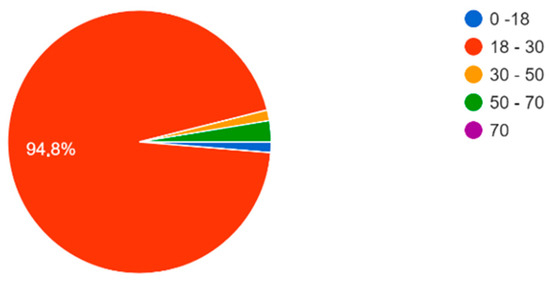
Figure 1.
Survey results—age.
6.4.2. Involvement in Cultural Heritage Preservation Activities
The survey revealed that most participants rarely participated in cultural heritage preservation activities. Although they expressed interest in the subject, their active involvement was limited, pointing to the need for greater engagement and promotion of these activities, especially among younger populations (Figure 2).
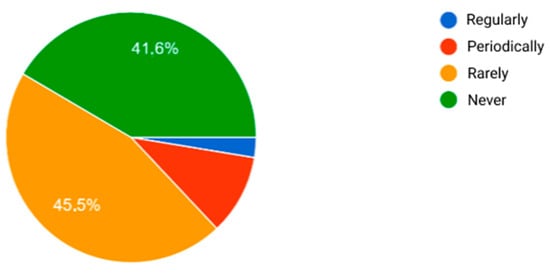
Figure 2.
Survey results—involvement in cultural heritage preservation activities.
6.4.3. Use of VR and AR Technologies in Education
The results showed that only 39% of participants had experience using VR and AR technologies to learn about cultural heritage, indicating significant room for integrating these technologies into educational programs. These findings confirm the need for increased investment in developing educational applications that use VR and AR to enhance engagement and the educational value of content (Figure 3).
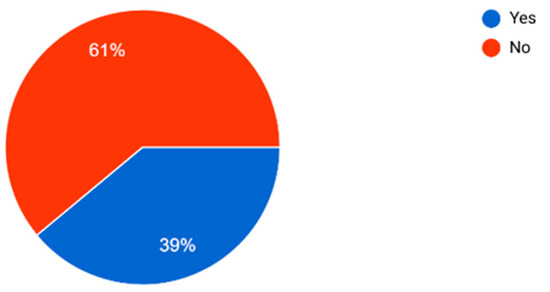
Figure 3.
Survey results—use of VR and AR technologies in education.
6.4.4. Interest in Participating in Interactive Workshops
The survey revealed a high level of interest in participating in interactive workshops that combine cultural heritage with new technologies. Most respondents expressed a desire to engage in such workshops, suggesting the potential for developing educational programs that use VR and AR technologies to increase engagement and interest in cultural heritage (Figure 4).
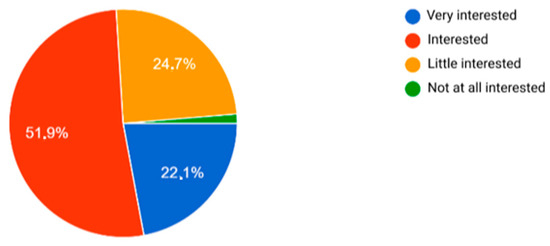
Figure 4.
Survey results—interest in participating in interactive workshops.
6.4.5. Willingness to Participate in Projects
More than 80% of participants stated that they were fully or partially willing to participate in projects that combine VR and AR technologies with cultural heritage education. This suggests significant potential for implementing projects that use immersive technologies to preserve and popularize cultural heritage (Figure 5).
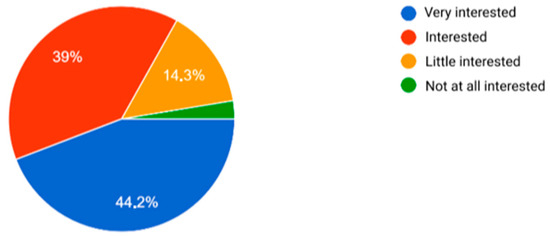
Figure 5.
Survey results—willingness to participate in projects.
6.4.6. Preferred Types of Cultural Heritage
Participants showed interest in various aspects of cultural heritage, with an emphasis on historical monuments and museum exhibits. These findings indicate that projects focused on these aspects of cultural heritage could have the greatest impact on users (Figure 6).
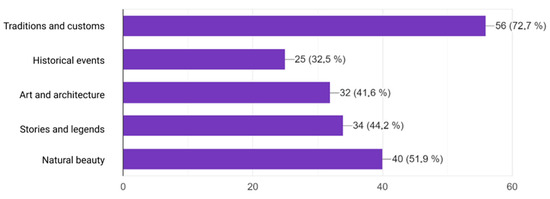
Figure 6.
Survey results—preferred types of cultural heritage.
6.5. Target Audience
The InHeritage mobile application is aimed at a wide range of users, with a particular focus on the following three key demographic groups:
- Primary and secondary school students (ages 10–18) who are learning about cultural heritage through school.
- Students and academics in fields such as history, archaeology, art, and related disciplines who want to explore cultural artifacts and sites in an interactive way.
- The general public and tourists interested in cultural heritage and seeking a richer, more interactive experience during museum visits or historical site explorations.
6.6. Three User Personas
To better understand the needs of target users, three personas were defined:
- Mia (12 years old, elementary school student): She wants to learn about cultural heritage through fun and interactive methods. She prefers apps that offer rewards and challenges, and she finds it difficult to stay interested using traditional learning methods.
- Ivan (22 years old, archaeology student): He seeks additional resources and interactive methods for learning and research. He values accuracy and the ability to deeply analyze information through technology.
- Ana (35 years old, tourist): She seeks a rich cultural experience while exploring historical sites. She uses apps to plan and enhance her travels, looking for additional information and interactive guides.
6.7. Mission, Vision, and Project Goals
- Mission: to enhance cultural heritage education through innovative technologies, allowing users to explore and learn in an interactive, fun, and engaging way.
- Vision: to become a leading app for cultural heritage education, connecting modern technologies with the preservation and promotion of cultural values.
- Goals:
- -
- Primary Goals: increase student engagement in learning about cultural heritage, provide an interactive experience that improves understanding and interest in history, and offer tourists a tool to better understand and enjoy cultural sites.
- -
- Secondary Goals: encourage institutions to implement immersive reality technologies in education and develop a reward system for users who actively participate and learn through the app.
6.8. Color Palettes and Fonts
- Color Palette (Figure 7):
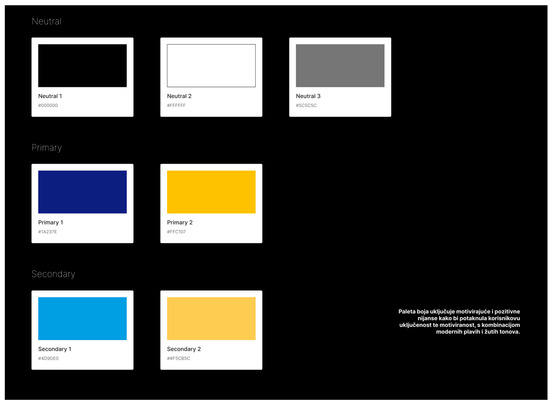 Figure 7. Color palette display.
Figure 7. Color palette display.- -
- Primary color: Dark blue (#1A237E)—symbolizes reliability and depth.
- -
- Secondary color: Gold (#FFC107)—symbolizes value and heritage.
- -
- Additional colors: White (#FFFFFF) for clarity and readability and gray (#757575) for neutral elements.
- Fonts (Figure 8):
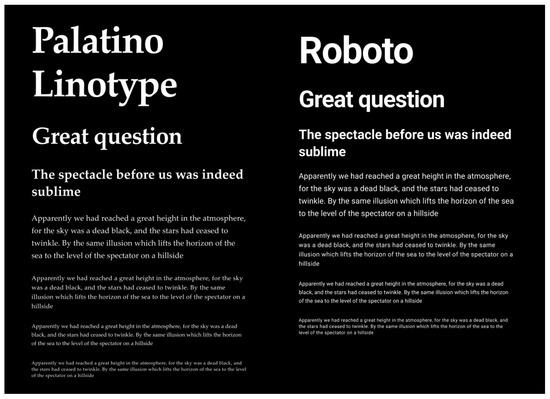 Figure 8. Display a combination of primary and secondary fonts.
Figure 8. Display a combination of primary and secondary fonts.- -
- Primary Font: Palatino Linotype—a modern sans-serif font that is readable and elegant.
- -
- Secondary Font: Roboto—a simple and clean font for longer texts.
6.9. Slogans (Figure 9 and Figure 10)
- -
- “Discover history through the latest technology”.
- -
- “Learn, explore, conquer”.
- -
- “Your journey through cultural heritage”.
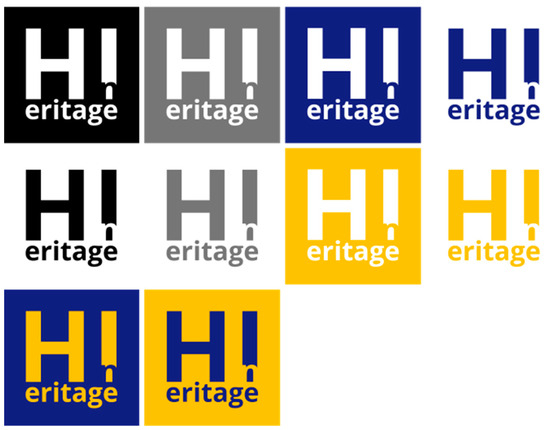
Figure 9.
Display of allowed combinations of logos (primary versions).
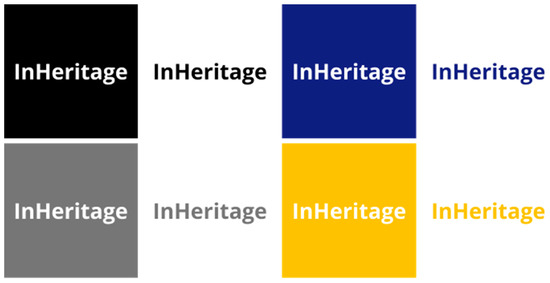
Figure 10.
Display of allowed combinations of logos (secondary versions).
6.10. Project Values
- Education: encouraging learning through innovative methods.
- Engagement: creating an interactive and enjoyable experience for users.
- Preservation: promoting awareness of the importance of preserving cultural heritage.
- Innovation: utilizing contemporary technologies to enhance educational processes.
6.11. Future Features of the Application
- Basic Phase:
- -
- Interactive 3D models of cultural artifacts.
- -
- Virtual tours of historical sites.
- -
- Educational games and quizzes with rewards for users.
- Proposals for Later Phases:
- -
- Personalized educational paths for users.
- -
- Integration with social media for sharing achievements.
- -
- Advanced AR functionalities for interaction with physical artifacts in the real world.
- -
- Development of a user community for sharing knowledge and experiences.
6.12. Branding and Visual Identity
The goal of branding for the InHeritage mobile application was to create a recognizable and appealing visual identity that reflects the app’s mission—connecting cultural heritage with modern technologies—ensuring that the app appeals to a diverse range of users, from students to tourists. The visual identity was designed to convey the seriousness and historical value of the content while incorporating modern elements that promote engagement and interactivity.
6.13. Key Branding Elements Include
Logo: The InHeritage logo is designed as a combination of cultural heritage symbols (such as a historical monument or museum building) and modern technology symbols (like a digital pixel or AR icon). The logo uses a primary dark blue color that symbolizes reliability and depth, with the addition of gold that reflects value and heritage.
Colors: The primary color palette includes dark blue (#1A237E) and gold (#FFC107), with white (#FFFFFF) and gray (#757575) as complementary colors. These colors are used to create contrast and highlight key elements on the screen, ensuring that the visual identity is consistent and recognizable.
Typography: The fonts Montserrat were chosen for headings and emphasized text and Roboto for body text due to their readability and modern look. These fonts also contribute to a professional and serious tone for the app while remaining accessible and easy to read.
Slogans: Slogans such as “Discover history through the latest technology” and “Learn, explore, conquer” are integrated into promotional materials and the app’s welcome screens, ensuring that the app’s mission is immediately clear to users.
Mobile Application Name: InHeritage is a name based on a play of words between “inherit” and “heritage”. This name suggests that users of the app are not only exploring cultural heritage but also “inheriting” it in an interactive way. The name reflects the idea that through the use of the app, users become active participants in the preservation and understanding of cultural heritage. Interactive methods, such as VR and AR, allow users to connect with history and culture in a personal and engaging way, inheriting that heritage in a modern context. InHeritage also emphasizes the transfer of knowledge and cultural values from generation to generation but in a modernized form through digital and interactive tools provided by the app.
The visual identity of the InHeritage mobile application sets the foundation for a recognizable brand that enables users to easily connect with the app’s goals and values.
7. Lo-Fi Design
At this stage of development, the focus was on creating a low-fidelity (lo-fi) prototype of the app to test basic user flows and navigation structure. The lo-fi prototype included simple wireframe displays that defined key screens and their functionalities (Figure 11, Figure 12 and Figure 13).
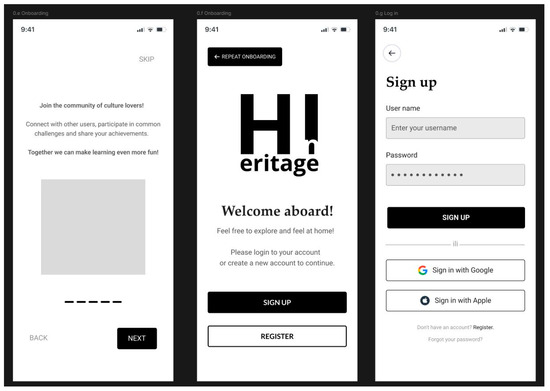
Figure 11.
Rendering of one section of the lo-fi InHeritage mobile app.
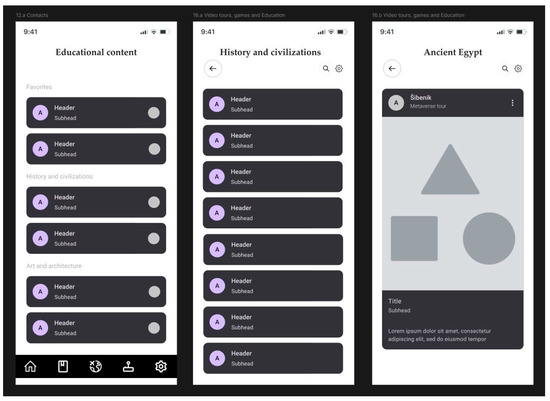
Figure 12.
Rendering of one section of the lo-fi InHeritage mobile app.
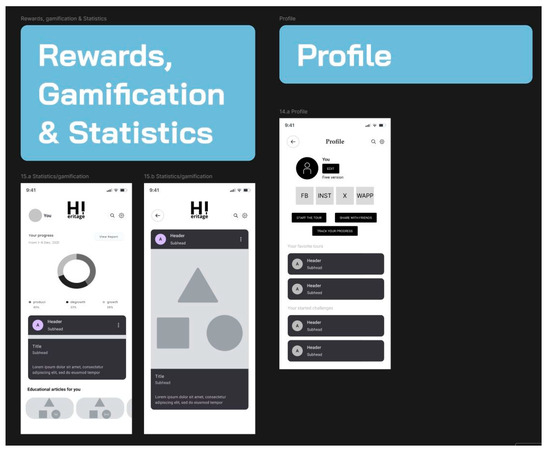
Figure 13.
Rendering of one section of the lo-fi InHeritage mobile app.
Key screens in the lo-fi prototype included the following:
- Home Screen: displaying simple navigation to the app’s key modules, such as virtual tours and educational content.
- Registration and Login: screens for creating a user account and logging in, with simple text fields and basic login buttons.
- Main Menu: displaying the app’s modules, including options to view virtual tours, educational content, and games.
- Virtual Tours: a basic layout for viewing virtual tours of cultural sites, with simple controls for navigating the tours.
- Educational Modules: interactive screens featuring content about cultural heritage, including basic elements like text boxes and images.
- Games and Quizzes: a screen for playing educational games and quizzes, with a simple interface that allows users to start the game or quiz.
- Reward System: a screen displaying users’ achievements and rewards, with a basic table view of points and prizes.
- User Profile: a screen showing personal achievements, usage history, and personalized settings.
- Settings: a screen for customizing the user experience, including language options and access to privacy information.
The lo-fi design of the application represents the initial stage of user interface development, where the main focus is on the structure and functionality of the app, without details such as colors, images, and fine visual elements.
Conclusions Based on the Lo-Fi Design Include
- Clear Information Hierarchy: The design clearly defines the basic categories and sections of the app, such as “Profile”, “Settings”, and “Video Tours, Games, and Education”. This allows users to easily understand the app’s structure and navigate through its main functionalities.
- Intuitive Navigation: The lo-fi design lays the groundwork for intuitive navigation throughout the app. Each key screen contains clearly marked functionalities, enabling users to move easily between different parts of the app, such as transitioning from the “Home Screen” to the “Profile” or “Settings”.
- Focus on Functionality: At this stage of design, the priority was to ensure that all major functionalities, such as search and personalization, were clearly defined and easy to use. Visual elements are minimal, allowing a focus on the app’s functional aspects.
- Accessibility of Design: The design uses simple and clean lines with minimal elements, ensuring that the user interface is easy to understand and accessible to a wide range of users. This reduces the possibility of confusion, even for those who are not tech savvy.
- Modular Approach: Screens are designed modularly, allowing for easy adjustments and iterations in later stages of development. This approach also facilitates the addition of new functionalities or modifications to existing ones without significantly impacting other parts of the app.
- Minimalist Design: The lo-fi phase retains a minimalist approach, avoiding distractions and focusing on basic user interactions with the app. This ensures that core functions are clearly recognizable and easily accessible.
These conclusions reflect how the lo-fi design provides a solid foundation for further app development, focusing on key aspects of functionality and user experience while leaving room for visual upgrades in later stages.
8. Hi-Fi Design
The hi-fi (high-fidelity) design of the “InHeritage” application represents the final version of the user interface (Figure 14, Figure 15 and Figure 16), where all elements are carefully crafted to provide the best possible user interaction. The design focuses on clarity, consistency, and user experience while maintaining a recognizable visual identity that reflects the cultural and educational value of the app.
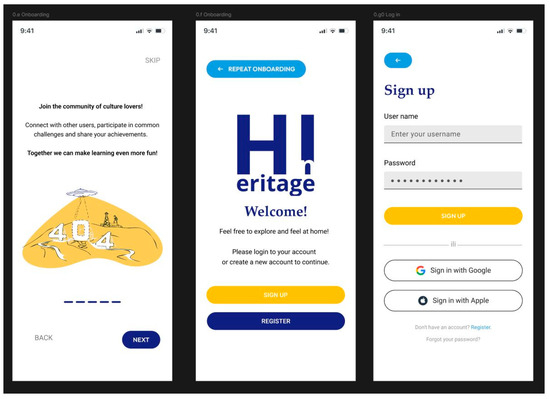
Figure 14.
Rendering of one section of the hi-fi InHeritage mobile app.
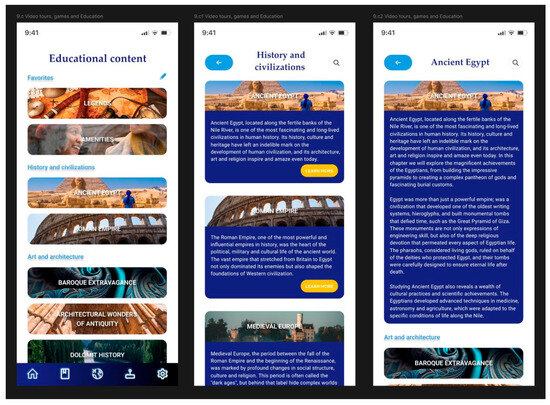
Figure 15.
Rendering of one section of the hi-fi InHeritage mobile app.
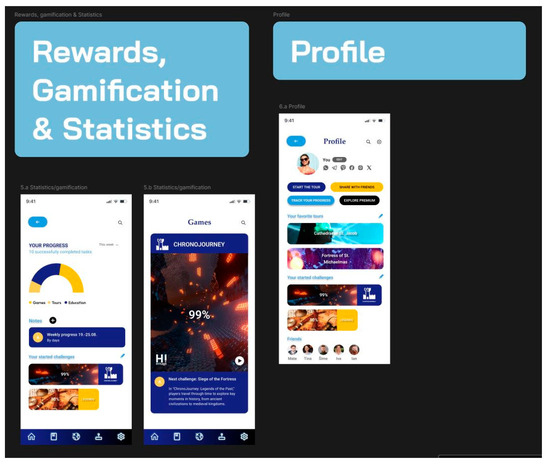
Figure 16.
Rendering of one section of the hi-fi InHeritage mobile app—final.
- Branding and Consistency
One of the most evident strengths of this design is the consistency in the use of colors and typography. The main colors are blue and yellow, which are not only aesthetically pleasing but also functional, as they facilitate navigation through the app. Blue dominates as the primary color, used for main actions, titles, and highlights, while yellow serves as a complementary color that draws attention to key interactions, such as login or registration buttons.
The fonts used are clear, readable, and mobile friendly, which is crucial for an app used on smaller screens. The typography in the app is simple and elegant, contributing to overall clarity and making the text easier to read. This consistency in branding elements ensures that users have a seamless experience without distractions.
- 2.
- Visual Hierarchy and Navigation
The visual hierarchy is well structured, with clear differentiation between various levels of information. Titles and subtitles are highlighted in blue, while textual content is presented in black, allowing for easy recognition of key information. Icons and illustrations are simple but effective, serving as visual guides that further simplify navigation throughout the app.
Navigation within the app is intuitive, with clearly defined paths guiding users through different sections of the app. Action buttons are prominently displayed, and informative texts provide context wherever necessary. All these features make the app accessible and easy to use, even for users who are not technically proficient.
- 3.
- Illustrations and Interactivity
The illustrations used in the app are modern and appealing while also aligned with the theme of education and cultural heritage. They not only add visual charm to the app but also help users connect with it on a deeper level, providing visual stimuli that make information easier to remember.
Interactive elements, such as video guides and virtual tours, are integrated in a way that allows users to access additional content without leaving the main interface. This ensures a smooth user experience, where all elements complement each other.
- 4.
- Advantages of Hi-Fi Design
Enhanced User Experience: Consistency in visual elements, such as colors, fonts, and iconography, ensures a simple and enjoyable user experience.
Clear Visual Hierarchy: Users can quickly find the necessary information thanks to a well-defined visual structure.
Intuitive Navigation: The app guides users through various stages without confusion, with well-placed navigation buttons and visual guides.
Aesthetics: The modern and appealing design of illustrations and interactive elements makes the app visually attractive, increasing user engagement.
Branding: Consistent use of colors and fonts helps strengthen brand recognition, ensuring that users easily associate the app with its purpose and goals.
Ultimately, the hi-fi design of the “InHeritage” application successfully combines functionality and aesthetics, providing users with a rich and informative experience that is both intuitive and visually appealing.
9. Useberry Testing of Hi-Fi Design
In the conducted Useberry testing, which involved nine users, the results showed mixed success in task completion (Figure 17). Out of nine users, six successfully completed the test, while three skipped certain tasks, resulting in a completion rate of 67% and a dropout rate of 33%.
The average time required to complete the entire study was 4 min and 13.7 s. Block-by-block analysis reveals different success rates and times required to complete tasks:
Block 1 had eight users, six of whom successfully completed the task, while two dropped out. The average time spent on this task was 1 min and 2.7 s.
Block 2 was successful for all six users who participated, with an average time of 24.7 s.
Block 3 had a lower success rate, with four completed tasks out of six users, while the average time lasted 1 min and 20.5 s.
Block 4 also had a 100% success rate, with all six users completing the task in an average of 8.4 s.
Block 5 recorded five successfully completed tasks out of six users, with an average time of 58.5 s.
Overall, the data suggest that some task blocks were more challenging than others, with longer durations and higher dropout rates. The results also indicate that some users quickly gave up (e.g., sessions of 11.1 s), which may point to engagement issues or technical difficulties during testing. Longer sessions, lasting up to 9 min, show that some users encountered difficulties or took more time to thoroughly study the tasks before completing them.
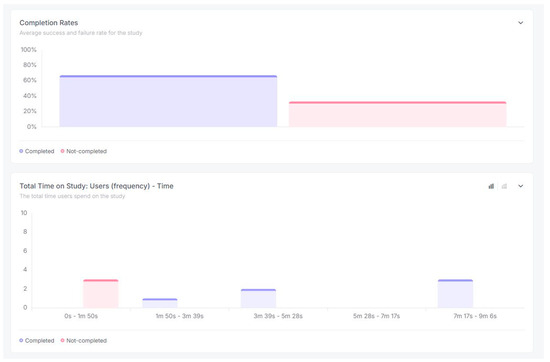
Figure 17.
Display of statistics of overall Useberry testing.
- Conclusion for Task 1: Launching the application (Figure 18)
Eight users participated in the task of launching the application, six of whom successfully completed the task, while two dropped out, resulting in a completion rate of 75% and a dropout rate of 25%. The average time required to complete the task was 1 min and 2.7 s.
Analyzing the user sessions, it is evident that users who completed the task spent varying amounts of time, ranging from 16.6 s to 2 min and 54.3 s. The fastest user completed the task in just 16.6 s, while the slowest user spent almost 3 min. This variation in time suggests that some users quickly understood and successfully executed the task, while others may have encountered difficulties or took more time to familiarize themselves with the application before completion.
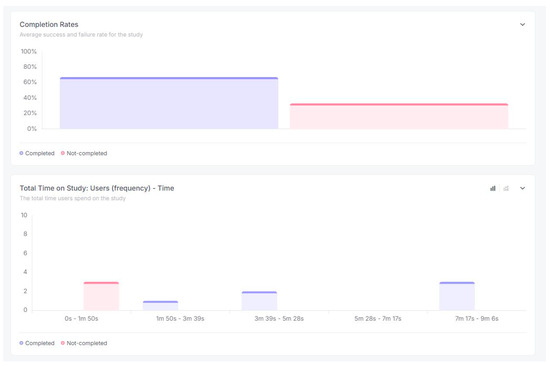
Figure 18.
Display of statistics Task 1: starting the application.
- 2.
- Conclusion for Task 2: Finish the 99% challenge (Figure 19)
The task “Finish the 99% challenge” proved to be very successful among users. All six participants successfully completed the task, resulting in a success rate of 100%. No users dropped out or skipped this task, indicating that it was intuitive and easy to understand for all participants.
Since all users completed the task, it can be concluded that the instructions were clear and that there were no significant obstacles or difficulties hindering the users. Visualization of user flows and click tracking could provide additional insights into how users approached the task, but the current data clearly show that it was well designed and user friendly.
In conclusion, this task was extremely well received by users, with no dropouts and relatively short completion times. These results suggest that users found the task challenging but not overly difficult and were able to complete the challenge with ease.
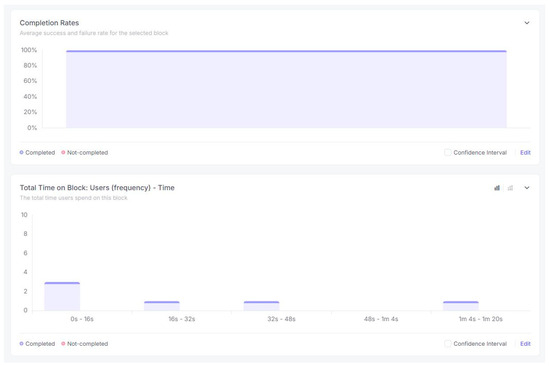
Figure 19.
View statistics Task 2: complete the 99% challenge.
- 3.
- Conclusion for Task 3: View your progress this week (Figure 20)
The task “View your progress this week” showed mixed results in completion success among users. Out of a total of six users, four successfully completed the task, while two users dropped out or skipped it. This results in a success rate of 67%, indicating certain challenges faced by some users.
The average time required to complete the task was 1 min and 20.5 s, which is significantly longer compared to the previous tasks. This may suggest that the task was more complex or less intuitive, requiring additional time to find and review the progress information.
Differences in execution time among users are also significant. While one user managed to complete the task in just 8.6 s, another spent as much as 5 min on it. These differences indicate that some users may have encountered difficulties in navigation or locating the necessary information, while others quickly grasped the task and completed it successfully.
The two users who dropped out of the task spent around 40 to 50 s before deciding not to continue. This information suggests that they encountered some obstacles or that the task was not clear enough, causing them to refrain from proceeding further.
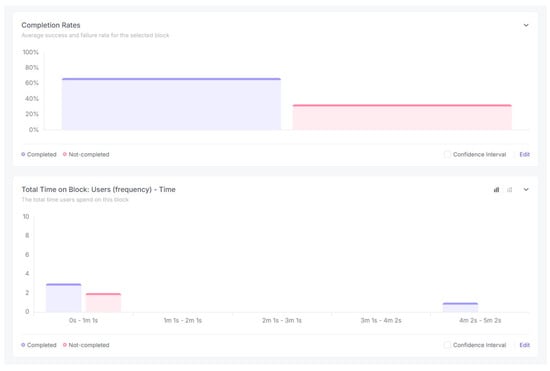
Figure 20.
Display of statistics Task 3: see your progress this week.
- 4.
- Conclusion for Task 4: Premium version (Figure 21)
The “Premium version” task demonstrated an extremely high success rate, with 100% of users successfully completing the task. Out of a total of six users, all completed the task, indicating that the process was simple and intuitive for all participants.
The average time required to complete the task was very short, just 8.4 s, suggesting that users quickly found and performed the required action. The fastest user completed the task in 2.7 s, while the slowest user spent 18.4 s on it. This minimal difference in completion time indicates consistency in the user experience, where most users were able to quickly understand and complete the task without any difficulties.
The 100% completion rate and short completion time suggest that this task, involving the Premium version, was designed in a very user friendly manner. Users had no difficulty finding the necessary options or performing the required actions, which speaks to the high quality of design and clear navigation within the application.
These results indicate that the process of purchasing or accessing the Premium version is very efficient and clearly understood by users. Furthermore, such results can instill confidence in the application, as users can easily access additional options without frustration or uncertainty.

Figure 21.
Display of statistics Task 4: Premium version.
- 5.
- Conclusion for Task 5: Ancient Egypt (Figure 22)
The “Ancient Egypt” task demonstrated a high level of success among users, with 83% of tasks successfully completed. Out of the six users who participated in the task, five completed it successfully, while one user abandoned it, resulting in a failure rate of 17%.
The average time required to complete the task was 58.5 s, indicating that the task was moderately demanding and that users needed some time to find and process the requested information. The time spent on the task varied among users, with the fastest user completing it in just 5.6 s, while the slowest user took 2 min and 17.3 s. This difference in time suggests that some users may have encountered minor difficulties or simply took more time to thoroughly explore the content.
Despite the variation in task completion time, the fact that most users successfully completed the task indicates that the design was intuitive for the majority. However, the existence of one user who failed to complete the task suggests potential areas of misunderstanding or ambiguity that could be further optimized to increase the success rate even more.

Figure 22.
Display of statistics Task 5: Ancient Egypt.
10. Conclusions
The conclusion of this work offers a comprehensive reflection on the hypotheses, an analysis of individual chapters, and emphasizes the suitability of developing and launching a gamified mobile application using XR technologies for the preservation of cultural heritage within the metaverse.
First, let us address the hypotheses. Throughout this work, three key hypotheses were tested, shaping the research and development of the application. The first hypothesis, suggesting that the integration of immersive technologies (VR and AR) and gamification within the metaverse significantly increases user engagement and motivation to learn about cultural heritage, was confirmed through a series of case studies and qualitative research. The second hypothesis, predicting high interest from the target audience in using mobile applications that employ modern technologies, was also confirmed through survey results and focus groups, which showed significant interest in interactive and gamified content. The third hypothesis, proposing that the development of a mobile application combining 3D modeling of cultural artifacts with gamification elements within the metaverse can increase awareness and understanding of cultural heritage among young people, was also supported by the results of prototype testing.
Each chapter of this work contributed to a detailed consideration of the relevant aspects for the successful launch of the application. The introductory chapter laid the groundwork for this research by defining the issue of cultural heritage preservation in the digital age and setting clear goals and hypotheses. The theoretical framework provided a detailed overview of key concepts such as gamification, XR technologies, and the metaverse, emphasizing their role in modern education and cultural heritage preservation. The analysis of existing solutions highlighted the shortcomings of current applications and pointed out the advantages and challenges of applying gamification and XR technologies.
The integration of the metaverse into educational applications was a key topic explored in several chapters, offering guidelines for the implementation and prototyping of applications within this new digital environment. Qualitative research, including focus groups and interviews, provided valuable insights into user perceptions and allowed for adjustments to the application design according to their needs and expectations.
The chapter dedicated to practical implementation presented the process of developing the application’s design, from the initial idea to the hi-fi prototype, including user experience testing and evaluation of the application’s effectiveness. This phase of research was crucial in confirming the functionality and appeal of the application, as well as identifying areas for future improvement.
Based on the research findings, it can be concluded that the development of a gamified mobile application using XR technologies for cultural heritage preservation within the metaverse is not only feasible but also an extremely promising project. The InHeritage mobile application, which utilizes modern technologies such as VR and AR in combination with gamification elements, offers an innovative approach to learning and preserving cultural heritage, particularly tailored to the needs and interests of younger generations. The high level of interest and positive prototype testing results indicate the potential for a successful market launch.
However, it is important to acknowledge the limitations of this research. One significant constraint was the sample size, which, while providing valuable insights, may not fully represent the broader population of potential users and stakeholders. The focus groups and interviews were conducted with a limited number of participants, primarily from academic and cultural heritage backgrounds. This could lead to bias in understanding the diverse perspectives of users from different demographics and geographical locations.
Additionally, this research relied heavily on self-reported data, which can be subject to biases such as social desirability or misinterpretation of questions. Future research could address these limitations by expanding the sample size and including a more diverse group of participants, such as educators, industry professionals, and casual users of cultural heritage apps. Longitudinal studies could also be beneficial to assess the long-term impact of using gamified XR technologies on learning outcomes and cultural engagement.
Moreover, future studies could explore specific aspects of user interaction with the InHeritage application, such as the effectiveness of various gamification strategies in promoting engagement and retention of cultural knowledge. Investigating the impact of different user demographics on their experience and interaction with XR technologies could provide deeper insights into how to tailor applications for diverse audiences. Additionally, research could examine the integration of AR features in physical locations, allowing for real-time interaction with cultural artifacts, further enriching the educational experience.
By identifying and addressing these challenges, future research can further contribute to the successful implementation of XR technologies in the preservation and promotion of cultural heritage. In conclusion, this work provides a foundation for the further development and implementation of the application, offering guidelines and recommendations for optimizing user experience and further research in the application of XR technologies in education and cultural heritage preservation. Considering all of the above, we can conclude that the application is ready for launch and has all the necessary characteristics for successful use in promoting and preserving cultural heritage.
For this project, I was honored to receive the Rector’s Award for the best scientific paper in the technical field at the University of Zagreb. Additionally, the conceptual design was presented at the ARCA Innovation Fair, where it earned a bronze medal, along with another bronze at the INOVA Fair, further enhancing the project’s credibility.
Author Contributions
Conceptualization, P.S. and T.S.; methodology, T.S.; software, P.S.; validation P.S., T.S., and M.M.; formal analysis, M.M.; investigation, T.S.; resources, M.M.; data curation, P.S.; writing—original draft preparation, T.S.; writing—review and editing, P.S.; visualization, M.M.; supervision, M.M.; project administration, T.S.; funding acquisition, M.M. All authors have read and agreed to the published version of the manuscript.
Funding
Funds provided through financial support from the University of Zagreb, Faculty of Graphic Arts, for research on the topic Integration and Application of Advanced 3D Technologies and Additive Manufacturing, led by Marko Maričević.
Data Availability Statement
The original contributions presented in the study are included in the article, further inquiries can be directed to the corresponding authors.
Conflicts of Interest
The authors declare no conflict of interest.
References
- Kapp, K.M. The Gamification of Learning and Instruction: Game-Based Methods and Strategies for Training and Education; Pfeiffer: San Francisco, CA, USA, 2012; Available online: https://www.researchgate.net/publication/273947281_The_gamification_of_learning_and_instruction_Game-based_methods_and_strategies_for_training_and_education_San_Francisco_CA_Pfeiffer (accessed on 13 December 2024).
- Deterding, S.; Dixon, D.; Khaled, R.; Nacke, L. From Game Design Elements to Gamefulness: Defining “Gamification”. In Proceedings of the 15th International Academic MindTrek Conference: Envisioning Future Media Environments, Tampere, Finland, 28–30 September 2011; Available online: https://dl.acm.org/doi/10.1145/2181037.2181040 (accessed on 13 December 2024).
- Anthes, C.; García-Hernández, R.J.; Wiedemann, M.; Kranzlmüller, D. State of the Art of Virtual Reality Technology. In Proceedings of the IEEE Aerospace and Electronic Systems Magazine, Big Sky, MT, USA, 5–12 March 2016; Available online: https://www.researchgate.net/publication/297760223_State_of_the_Art_of_Virtual_Reality_Technologies (accessed on 13 December 2024).
- Bekele, M.K.; Champion, E. A comparison of immersive realities and interaction methods: Cultural learning in virtual heritage. Front. Robot. AI 2019, 6, 91. [Google Scholar] [CrossRef]
- Huotari, K.; Hamari, J. A definition for gamification: Anchoring gamification in the service marketing literature. Electron. Mark. 2017, 27, 21–31. [Google Scholar] [CrossRef]
- Werbach, K.; Hunter, D. For the Win: The Power of Gamification and Game Thinking in Business, Education, Government, and Social Impact; Wharton School Press: Philadelphia, PA, USA, 2012; Available online: https://wdp.wharton.upenn.edu/book/for-the-win/ (accessed on 13 December 2024).
- Zichermann, G.; Cunningham, C. Gamification by Design: Implementing Game Mechanics in Web and Mobile Apps; O’Reilly Media: Sebastopol, CA, USA, 2011; Available online: https://books.google.hr/books/about/Gamification_by_Design.html?id=Hw9X1miVMMwC&redir_esc=y (accessed on 13 December 2024).
- Bunchball. Gamification 101: An Introduction to the Use of Game Dynamics to Influence Behavior. White Paper. 2010. Available online: http://jndglobal.com/wp-content/uploads/2011/05/gamification1011.pdf (accessed on 13 December 2024).
- Deci, E.L.; Ryan, R.M. The “what” and “why” of goal pursuits: Human needs and the self-determination of behavior. Psychol. Inq. 2000, 11, 227–268. [Google Scholar] [CrossRef]
- Hamari, J.; Koivisto, J.; Sarsa, H. Does Gamification Work?—A Literature Review of Empirical Studies on Gamification. In Proceedings of the 2014 47th Hawaii International Conference on System Sciences, Waikoloa, HI, USA, 6–9 January 2014; Available online: https://ieeexplore.ieee.org/document/6758978 (accessed on 13 December 2024).
- Johnson, D.; Deterding, S.; Kuhn, K.A.; Staneva, A.; Stoyanov, S.; Hides, L. Gamification for health and wellbeing: A systematic review of the literature. Internet Interv. 2016, 6, 89–106. [Google Scholar] [CrossRef]
- Rigby, S.; Ryan, R.M. Glued to Games: How Video Games Draw Us in and Hold Us Spellbound; Praeger: Westport, CT, USA, 2011; Available online: https://www.academia.edu/14931342/Glued_to_Games (accessed on 13 December 2024).
- Landers, R.N.; Landers, A.K. An empirical test of the theory of gamified learning: The effect of leaderboards on time-on-task and academic performance. Simul. Gaming 2014, 45, 769–785. [Google Scholar] [CrossRef]
- Azuma, R.T. Azuma, R.T. A Survey of Augmented Reality. In Presence: Teleoperators & Virtual Environments; MIT Press: Cambridge, MA, USA, 1997; Available online: https://www.cs.unc.edu/~azuma/ARpresence.pdf (accessed on 13 December 2024).
- Slater, M.; Sanchez-Vives, M.V. Enhancing our lives with immersive virtual reality. Front. Robot. AI 2016, 3, 74. [Google Scholar] [CrossRef]
- Cipresso, P.; Giglioli, I.A.C.; Raya, M.A.; Riva, G. The past, present, and future of virtual and augmented reality research: A network and cluster analysis of the literature. Front. Psychol. 2018, 9, 2086. [Google Scholar] [CrossRef] [PubMed]
- Merchant, Z.; Goetz, E.T.; Cifuentes, L.; Keeney-Kennicutt, W.; Davis, T.J. Effectiveness of virtual reality-based instruction on students’ learning outcomes in K-12 and higher education: A meta-analysis. Comput. Educ. 2014, 70, 29–40. [Google Scholar] [CrossRef]
- Radianti, J.; Majchrzak, T.A.; Fromm, J.; Wohlgenannt, I. A systematic review of immersive virtual reality applications for higher education: Design elements, lessons learned, and research agenda. Comput. Educ. 2020, 147, 103778. [Google Scholar] [CrossRef]
- Billinghurst, M.; Clark, A.; Lee, G. A Survey of Augmented Reality. Found. Trends Hum. Comput. Interact. 2015, 8, 73–272. [Google Scholar] [CrossRef]
- Bacca, J.; Baldiris, S.; Fabregat, R.; Graf, S.; Kinshuk. Augmented reality trends in education: A systematic review of research and applications. Educ. Technol. Soc. 2014, 17, 133–149. Available online: https://www.researchgate.net/publication/286049823_Augmented_Reality_Trends_in_Education_A_Systematic_Review_of_Research_and_Applications (accessed on 13 December 2024).
- Akçayır, M.; Akçayır, G. Advantages and challenges associated with augmented reality for education: A systematic review of the literature. Educ. Res. Rev. 2017, 20, 1–11. [Google Scholar] [CrossRef]
- Wu, H.K.; Lee, S.W.Y.; Chang, H.Y.; Liang, J.C. Current status, opportunities and challenges of augmented reality in education. Comput. Educ. 2013, 62, 41–49. [Google Scholar] [CrossRef]
- Milgram, P.; Kishino, F. A Taxonomy of Mixed Reality Visual Displays. IEICE Trans. Inf. Syst. 1994, 77, 1321–1329. Available online: https://search.ieice.org/bin/summary.php?id=e77-d_12_1321 (accessed on 13 December 2024).
- Rizzetto, F.; Bernareggi, A.; Rantas, S.; Vanzulli, A.; Vertemati, M. Immersive Virtual Reality in surgery and medical education: Diving into the future. Am. J. Surg. 2020, 220, 856–857. [Google Scholar] [CrossRef] [PubMed]
- Nee, A.Y.C.; Ong, S.K.; Chryssolouris, G.; Mourtzis, D. Augmented reality applications in design and manufacturing. CIRP Ann. 2012, 61, 657–679. [Google Scholar] [CrossRef]
- Tran, C.; Bark, K.; Beckwith, L.; Ng-Thow-Hing, V. User-Centered Perspectives for Automotive Augmented Reality. In Proceedings of the 2013 IEEE International Symposium on Mixed and Augmented Reality—Arts, Media, and Humanities (ISMAR-AMH), Adelaide, SA, Australia, 1–4 October 2013; Available online: https://www.researchgate.net/publication/261447349_User-centered_perspectives_for_automotive_augmented_reality (accessed on 13 December 2024).
- Addison, A.C. Emerging trends in virtual heritage. IEEE Multimed. 2000, 7, 22–25. [Google Scholar] [CrossRef]
- Koller, D.; Frischer, B.; Humphreys, G. Research challenges for digital archives of 3D cultural heritage models. J. Comput. Cult. Herit. 2009, 2, 1–17. [Google Scholar] [CrossRef]
- Champion, E.; Rahaman, H. 3D digital heritage models as sustainable scholarly resources. Sustainability 2019, 11, 2425. [Google Scholar] [CrossRef]
- CyArk. CyArk: Digital Preservation of Cultural Heritage. 2020. Available online: https://www.cyark.org/ (accessed on 13 December 2024).
- Europeana. Europeana Collections. 2020. Available online: https://www.europeana.eu/ (accessed on 13 December 2024).
- Apollonio, F.I.; Gaiani, M.; Sun, Z. 3D modeling and data enrichment in digital reconstruction of architectural heritage. ISPRS Ann. Photogramm. Remote Sens. Spat. Inf. Sci. 2012, XL-5/W2, 43–48. [Google Scholar] [CrossRef]
- Remondino, F.; El-Hakim, S. Image-based 3D modelling: A review. Photogramm. Rec. 2006, 21, 269–291. [Google Scholar] [CrossRef]
- Guidi, G.; Russo, M.; Angheleddu, D. 3D survey and virtual reconstruction of archaeological sites: A case study in central Italy. J. Archaeol. Sci. 2014, 1, 55–69. [Google Scholar] [CrossRef]
- Goodchild, M. Geographic information systems and science: Today and tomorrow. Procedia Earth Planet. Sci. 2009, 1, 1037–1043. [Google Scholar] [CrossRef]
- Lobo, M.-J.; Christophe, S. Opportunities and challenges for Augmented Reality situated geographical visualization. ISPRS Ann. Photogramm. Remote Sens. Spat. Inf. Sci. 2020, V-4-2020, 163–170. [Google Scholar] [CrossRef]
- Sala, N. Virtual Reality, Augmented Reality, and Mixed Reality in Education: A Brief Overview; IGI Global Scientific Publishing: Hershey, PA, USA, 2021; Available online: https://www.researchgate.net/publication/351365924_Virtual_Reality_Augmented_Reality_and_Mixed_Reality_in_Education_A_Brief_Overview (accessed on 13 December 2024).
- Hernandez Godoy, C., Jr. Augmented reality and virtual reality in education: A systematic review of literature. J. Educ. Technol. Soc. 2021, 5, 39–45. [Google Scholar] [CrossRef]
- Biocca, F.; Delaney, B. Immersive Virtual Reality Technology. In Communication in the Age of Virtual Reality; Routledge: New York, NY, USA, 1995; Available online: https://www.taylorfrancis.com/books/mono/10.4324/9781410603128/communication-age-virtual-reality-frank-biocca-mark-levy (accessed on 13 December 2024).
- Chang, H.-Y.; Binali, T.; Liang, J.-C.; Chiou, G.-L.; Cheng, K.-H.; Lee, S.W.-Y.; Tsai, C.-C. Ten years of augmented reality in education: A meta-analysis of (quasi-) experimental studies to investigate the impact. Comput. Educ. 2022, 191, 104641. [Google Scholar] [CrossRef]
- Klopfer, E.; Squire, K. Environmental detectives: The impact of learning through the use of augmented reality. Educ. Technol. Res. Dev. 2008, 56, 203–228. [Google Scholar] [CrossRef]
- Liarokapis, F.; Anderson, E.F. Graphics and Virtual Environments for Serious Games. IEEE Comput. Graph. Appl. 2020, 40, 8–9. [Google Scholar] [CrossRef]
- Popovici, N.; Florin, G.; Bautu, E.; Boboc, R. Augmented Reality in Cultural Heritage: An Overview of the Last Decade of Applications. Appl. Sci. 2022, 12, 9859. [Google Scholar] [CrossRef]
- Torabmostaedi, H.; Roy, R.; Erkoyuncu, J.A.; Palmarini, R. A systematic review of augmented reality applications in maintenance. Robot. Comput. Integr. Manuf. 2018, 49, 215–228. [Google Scholar] [CrossRef]
- González-Zamar, M.-D.; Abad-Segura, E. Implications of Virtual Reality in Arts Education: Research Analysis in the Context of Higher Education. Educ. Sci. 2020, 10, 225. [Google Scholar] [CrossRef]
- O’Connor, Y.; Mahony, C. Exploring the impact of augmented reality on student academic self-efficacy in higher education. Comput. Hum. Behav. 2023, 149, 107963. [Google Scholar] [CrossRef]
- Cardador, M.T.; Northcraft, G.B.; Whicker, J. A Theory of Work Gamification: Something Old, Something New, Something Borrowed, Something Cool? Hum. Resour. Manag. Rev. 2017, 27, 353–365. Available online: https://www.sciencedirect.com/science/article/abs/pii/S1053482216300687 (accessed on 19 December 2024). [CrossRef]
- Liao, C.-H.D.; Wu, W.-C.V.; Chang, T.-C.; Lee, C.-H. The Impact of Augmented Reality on Vocabulary Learning of EFL Elementary School Students. In Proceedings of the 29th International Conference on Computers in Education, Online, 22–26 November 2021; Available online: https://icce2021.apsce.net/wp-content/uploads/2022/01/ICCE2021-Vol.I-PP.-418-420.pdf (accessed on 13 December 2024).
- Zulfiqar, F.; Raza, R.; Khan, M.O.; Arif, M. Augmented Reality and Its Applications in Education: A Systematic Survey. IEEE Access 2023, 11, 143250–143271. [Google Scholar] [CrossRef]
- Chinn, C.A.; Malhotra, B.A. Epistemologically authentic inquiry in schools: A theoretical framework for evaluating inquiry tasks. Sci. Educ. 2002, 86, 175–218. [Google Scholar] [CrossRef]
- Bishop, J.L.; Verleger, M.A. The Flipped Classroom: A Survey of the Research. In Proceedings of the 2013 ASEE Annual Conference & Exposition, Atlanta, GA, USA, 23–26 June 2013; Available online: https://peer.asee.org/the-flipped-classroom-a-survey-of-the-research (accessed on 13 December 2024).
- Lee, J.J.; Hammer, J. Gamification in education: What, how, why bother? Acad. Exch. Q. 2011, 15, 146. Available online: https://www.researchgate.net/publication/258697764_Gamification_in_Education_What_How_Why_Bother (accessed on 13 December 2024).
- Hwang, G.-J.; Wu, P.-H. Effects of an augmented reality-based educational game on students’ learning achievements and attitudes in real-world observations. Interact. Learn. Environ. 2015, 24, 1895–1906. [Google Scholar] [CrossRef]
- Chang, R.-C.; Yu, Z.-S. Using Augmented Reality Technologies to Enhance Students’ Engagement and Achievement in Science Laboratories. Int. J. Distance Educ. Technol. (IJDET) 2018, 16, 19. [Google Scholar] [CrossRef]
- Cao, W.; Yu, Z. RETRACTED ARTICLE: The impact of augmented reality on student attitudes, motivation, and learning achievements—A meta-analysis (2016–2023). Humanit. Soc. Sci. Commun. 2023, 10, 352. [Google Scholar] [CrossRef]
Disclaimer/Publisher’s Note: The statements, opinions and data contained in all publications are solely those of the individual author(s) and contributor(s) and not of MDPI and/or the editor(s). MDPI and/or the editor(s) disclaim responsibility for any injury to people or property resulting from any ideas, methods, instructions or products referred to in the content. |
© 2024 by the authors. Licensee MDPI, Basel, Switzerland. This article is an open access article distributed under the terms and conditions of the Creative Commons Attribution (CC BY) license (https://creativecommons.org/licenses/by/4.0/).